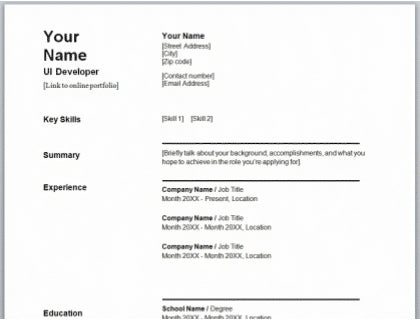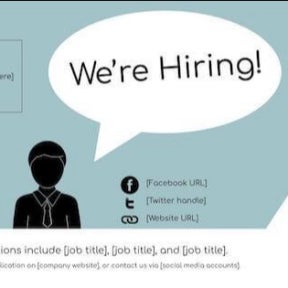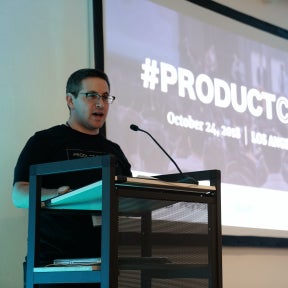
UI Developer Resume Free Template Download:
Download this UI developer resume template in MS Word format.
Download NowUI Developer Resume Example:
Your Name
UI Developer
[Link to online portfolio / website / LinkedIn profile]
[Street address]
[City]
[Zip code]
[Contact number]
[Email address]
Summary:
[Briefly talk about your background, skills, and qualifications.]
Key Skills:
[Skill 1]
[Skill 2]
Experience:
Company Name / Job Title Month 20XX - Present, Location
Company Name / Job Title Month 20XX - Month 20XX, Location
Company Name / Job Title Month 20XX - Month 20XX, Location
Education:
School Name / Degree Month 20XX - Month 20XX, Location
Institution Name / Certificate Month 20XX - Month 20XX, Location
Notable Achievements:
[Achievement 1]
[Achievement 2]
Awards and Promotions:
[Award 1]
[Job Promotion 1]
How to Write a UI Developer Resume:

A complete guide to writing a UI developer resume with a free template.
Start with a summary.
Write a compelling summary.

You'd need your summary to create a lasting impression, intriguing employers enough to continue reading your resume. Start by showcasing your most desirable qualities including your skills, years of experience, and top achievements.
Keep your summary short and to the point.

Aim to keep your summary under four sentences and only include the most pertinent information. Add a sentence about how your specific skill set and experience will benefit the employer's organization.
Showcase your technical skills.
List your most important skills first.

Mention your core UI developer skills first, such as graphic design, human-computer interaction research, coding interactive web elements, human behavior analysis, and your proficiency in programming languages.
Be sure to mention all relevant skills that could set you apart from other candidates.
Match your skill set with the job posting.

Directly match your skills with the job requirements and do not list skills that will not be needed for the position. You'll want to include all relevant skills and competencies you have acquired over time.
Be truthful.

When listing your skills, remain honest about your level of expertise as the hiring process may require practical assessments.
Outline your experience.
Add your experience in reverse chronological order.

The work experience section is an imperative part of your resume as employers will want to read about the UI projects and tasks you've completed in previous roles. In this section, list your most recent position first.
Add the places you have worked.

Pay special attention to the responsibilities you were assigned in previous positions. This will help employers picture you in the role and determine the type of tasks you're adept at.
Add your education information.
List your qualifications.

In reverse chronological order, add your qualifications. Each qualification entry should mention an institution name, the dates of attendance, and a location.
Mention qualifications in progress.

If you're studying towards a qualification, indicate it at the start of this section. Omit the initial date and instead include the words "In Progress."
List any relevant certificates.

Although your portfolio of UI projects already says a lot about you and your abilities, to help improve your chances of an interview, consider adding relevant certifications, even if not required.
Be sure to include the institution and the date you obtained your certification. Certificates awarded by accredited institutions indicate to employers that you have formal training and that you're passionate about your job.
Highlight your career achievements.
Add career milestones.

Your career highlights are a great addition to your resume because they act as solid references, proving to employers that you're more than capable of exceeding their expectations.
You'll immediately want to capture an employer's attention, so start this section with your most notable UI projects.
Showcase major completed projects.

You'll want to provide sufficient details of your proudest accomplishments, for example, developing prototype concepts for popular websites, successfully implementing new features, developing plugins for increased functionality, and resolving browser compatibility issues.
Be sure to include metrics to emphasize the impact your achievements had on the business. The more specific, the better.
Add any awards and job promotions.
Add key career highlights at the end of your resume.

These typically include professional achievements, such as awards or job promotions that may be of particular interest to employers.
Provide the details of your professional achievements.

Use bullet points to briefly describe each highlight and list them in reverse chronological order. Remember that each entry should also identify the institution/employer. Don't forget to provide a date.
What Employers Look for in a UI Developer's Resume:
- A list of programming languages you are proficient in. Popular languages for UI developers include ReactJS, Angular, HTML, and Java.
- A list of design skills including proficiency with Adobe Illustrator, Axure RP, InVision, UXPin, and more.
- A history of testing products and a demonstrated ability identifying problems and providing solutions to them.
- Evidence of working as part of a team and with different departments, including marketing.
- A user-first design philosophy with experience in human-computer interaction research.
- A history of working under pressure to meet client deadlines.
- An understanding of client needs and the ability to adapt to different design and development challenges.
- A relevant degree in computer science or a related field. A background in psychology or human-interaction design is beneficial.
- A link to an online portfolio of work that demonstrates a wide range of UI development projects.


